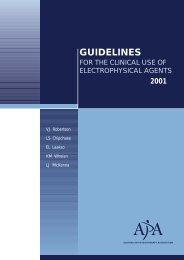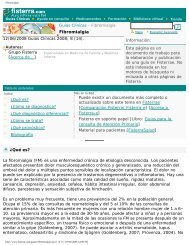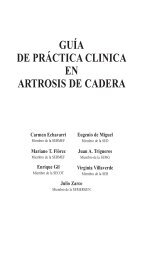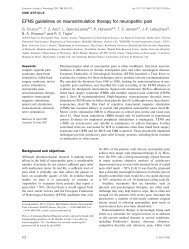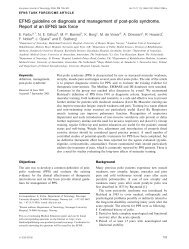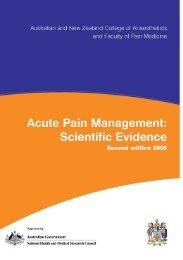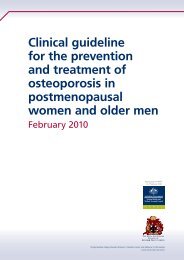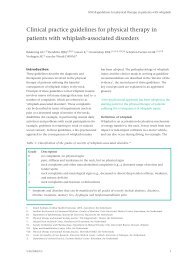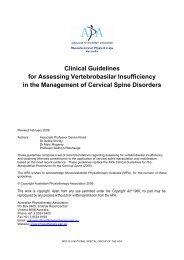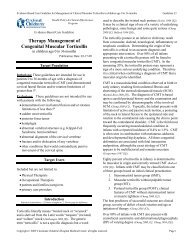Work-Related Radial Nerve Entrapment: Diagnosis and Treatment
Work-Related Radial Nerve Entrapment: Diagnosis and Treatment
Work-Related Radial Nerve Entrapment: Diagnosis and Treatment
You also want an ePaper? Increase the reach of your titles
YUMPU automatically turns print PDFs into web optimized ePapers that Google loves.
Medical <strong>Treatment</strong> GuidelinesWashington State Department of Labor <strong>and</strong> Industries<strong>Work</strong>-<strong>Related</strong> <strong>Radial</strong> <strong>Nerve</strong> <strong>Entrapment</strong>:<strong>Diagnosis</strong> <strong>and</strong> <strong>Treatment</strong>*I. IntroductionTable of ContentsII.III.Establishing <strong>Work</strong>-<strong>Related</strong>nessMaking the <strong>Diagnosis</strong>A. Symptoms <strong>and</strong> SignsB. Electrodiagnostic TestingC. Other Diagnostic TestsIV.<strong>Treatment</strong>A. Conservative <strong>Treatment</strong>B. Surgical <strong>Treatment</strong>V. Return to <strong>Work</strong> (RTW)A. Early AssessmentB. Returning to <strong>Work</strong> following SurgeryVI.VII.Electrodiagnostic <strong>Work</strong>sheetGuideline Summary*This guideline does not apply to severe or acute traumatic injury to the upper extremities.Effective Date April 1, 2010 Page 1
I. INTRODUCTION<strong>Work</strong>-<strong>Related</strong> <strong>Radial</strong> <strong>Nerve</strong> <strong>Entrapment</strong>:<strong>Diagnosis</strong> <strong>and</strong> <strong>Treatment</strong>This guideline is to be used by physicians, Labor <strong>and</strong> Industries claim managers, occupational nurses, <strong>and</strong>utilization review staff. The emphasis is on accurate diagnosis <strong>and</strong> treatment that is curative orrehabilitative (see WAC 296-20-01002 for definitions). An electrodiagnostic worksheet <strong>and</strong> guidelinesummary are appended to the end of this document.This guideline was developed in 2010 by the Washington State Industrial Insurance Medical AdvisoryCommittee (IIMAC) <strong>and</strong> its subcommittee on Upper Extremity <strong>Entrapment</strong> Neuropathies. Thesubcommittee presented its work to the full IIMAC, <strong>and</strong> the IIMAC made an advisory recommendation tothe Washington State Department of Labor & Industries to adopt the guideline. This guideline was basedon the weight of the best available clinical <strong>and</strong> scientific evidence from a systematic review of theliterature * <strong>and</strong> a consensus of expert opinion. One of the Committee's primary goals is to providest<strong>and</strong>ards that ensure a uniformly high quality of care for injured workers in Washington State.<strong>Radial</strong> nerve entrapment (RNE) is uncommon in the absence of acute trauma. When it occurs in relationto work, RNE usually refers to one of two syndromes: radial tunnel syndrome (RTS) or posteriorinterosseous nerve syndrome (PINS) 1,2 . Although RNE may occur from compression at any point alongthe course of the radial nerve due to acute trauma (e.g. humerus fracture, Saturday night palsy), spaceoccupyinglesion (e.g. lipoma, ganglion), local edema or inflammation, this guideline focuses on RTS <strong>and</strong>PINS, which are more typical for RNE arising from repetitive work activities.RTS <strong>and</strong> PINS have been described to occur at one of five potential sites. These sites, from proximal todistal, include the fibrous b<strong>and</strong>s of the radiocapitellar joint, radial recurrent vessels (the leash of Henry),the tendinous edge of the extensor carpi radialis brevis, the arcade of Frohse, <strong>and</strong> the distal edge of thesupinator. Most cases of RNE have been described at the arcade of Frohse.In general, work-relatedness <strong>and</strong> appropriate symptoms <strong>and</strong> objective signs must be present forLabor <strong>and</strong> Industries to accept RNE on a claim. Electrodiagnostic studies (EDS), including nerveconduction velocity studies (NCVs) <strong>and</strong> needle electromyography (EMG), should be scheduledimmediately to confirm the clinical diagnosis. If time loss extends beyond two weeks or if surgery isrequested, completion of EDS is required <strong>and</strong> does not need prior authorization.II. ESTABLISHING WORK-RELATEDNESS<strong>Work</strong> related activities may cause or contribute to the development of RNE. Establishing workrelatednessrequires all of the following:1. Exposure: <strong>Work</strong>place activities that contribute to or cause RNE, <strong>and</strong>2. Outcome: A diagnosis of RNE that meets the diagnostic criteria under Section III, <strong>and</strong>3. Relationship: Generally accepted scientific evidence, which establishes on a more probable thannot basis (greater than 50%) that the workplace activities (exposure) in an individual casecontributed to the development or worsening of the condition (outcome).When the Department receives notification of an occupational disease, the Occupational Disease &Employment History form is mailed to the worker, employer or attending provider. The form should be* Evidence was classified using criteria defined by the American Academy of Neurology (see references)Effective Date April 1, 2010 Page 2
completed <strong>and</strong> returned to the insurer as soon as possible. If the worker’s attending provider completesthe form, provides a detailed history in the chart note, <strong>and</strong> gives an opinion on causality, he or she may bepaid for this (use billing code 1055M). Additional billing information is available in the AttendingDoctor’s H<strong>and</strong>book.Certain work-related activities have been associated with RNE, usually those requiring forceful <strong>and</strong>repetitive elbow extension <strong>and</strong> forearm supination, h<strong>and</strong>ling of loads greater than 1 kg, <strong>and</strong> firm pinchingor squeezing of objects or h<strong>and</strong> tools 3,4 . Jobs where these activities often occur may include but are notlimited to the following 3,5-8 :ConstructionMachine tuningSewingSmeltingAssembly line inspectionPackingSeveral occupations have been described in association with RNE. This is not an exhaustive list <strong>and</strong> ismeant only as a guide in the consideration of work-relatedness 5-9 :Truck driverAssembly line workerTelevision industry workerMechanicSeamstressCement or brick layerAutomobile brakes industry workerShoes <strong>and</strong> clothing industry workerIce cream packerSecretaryIII. MAKING THE DIAGNOSISA. SYMPTOMS AND SIGNSA case definition of confirmed RNE includes appropriate symptoms, objective physical findings("signs"), <strong>and</strong> abnormal electrodiagnostic studies. A provisional diagnosis of RNE may be made basedupon appropriate symptoms <strong>and</strong> objective signs, but confirmation of the diagnosis requires abnormalEDS.Symptoms associated with RNE may include weakness in radial innervated muscles <strong>and</strong> pain or achingover the proximal, lateral forearm. Patients may report an increase in pain severity with an increase inactivity or during sleep. Loss of motor function is most common with PINS 10 .Signs on examination may include tenderness over the radial nerve distal to the lateral epicondyle.Tenderness on palpation is a useful objective finding, but cannot support the diagnosis of RNE alone.Motor findings include difficulty extending the thumb, fingers, or wrist 11 . Motor testing should comparestrength of radial innervated muscles to strength of the same muscles in the non-affected limb as well asnon-radial innervated muscles of the affected limb (see Table 1). Atrophy of affected muscles may beseen in chronic or severe cases.Provocative tests have been described to help corroborate the diagnosis of RNE. These include pressureover the radial tunnel (“radial nerve compression test”), resisted supination with the elbow extended(“resisted supination test”), <strong>and</strong> resisted extension of the middle-finger at the metacarpophalangeal joint(“middle-finger test”). These tests are based on creating maximal tension on the anatomical sites that areinvolved in RNE 12 . However, sensitivity <strong>and</strong> specificity of these tests have not been established <strong>and</strong> thesetests can not replace the objective signs discussed below.Effective Date April 1, 2010 Page 3
Table 1. Muscles Innervated by the <strong>Radial</strong> <strong>Nerve</strong>In the arm, via the muscular branch of the radial nervetriceps brachii (long head, medial head, lateral head)anconeousbrachioradialisextensor carpi radialis longusIn the forearm, via the deep branch of the radial nerveextensor carpi radialis brevissupinatorIn the forearm, via the posterior interosseous nerve:extensor digitorum communisextensor digiti minimiextensor carpi ulnarisabductor pollicis longusextensor pollicis brevisextensor pollicis longusextensor indicis propriusEvery effort should be made to objectively confirm the diagnosis of RNE before considering surgery. Adifferential diagnosis for RNE includes extensor tendinitis <strong>and</strong> lateral epicondylitis (which can coexistwith RNE), neuralgic amyotrophy, brachial plexopathy, or cervical radiculopathy 5,13 14 .B. ELECTRODIAGNOSTIC STUDIES (EDS)Electromyographic (EMG) abnormalities are required to objectively confirm the diagnosis of RNE. NCVabnormalities, such as radial motor or sensory conduction block across the elbow, or reduced sensorynerve action potentials, are of unproven utility, so NCV alone should not be relied upon to confirm thediagnosis. EDS confirmation requires abnormal EMG, with evidence of denervation in muscles suppliedby the posterior interosseous nerve with or without denervation in other radial-innervated forearmmuscles. EDS should exclude other potential causes of neuropathic symptoms, such as cervicalradiculopathy, brachial plexopathy, or neuralgic amyotrophy. A worksheet to help interpret EDS results isprovided in Section VI.C. OTHER DIAGNOSTIC TESTSIt has been suggested that Magnetic Resonance Imaging (MRI) neurography may be helpful in thediagnosis of RNE 15 . However, these services will not be authorized for this condition because theirclinical utility has not yet been proven. While the Committee recognizes that MRI neurography may beuseful in unusual circumstances where EDS results are normal in a patient with appropriate clinicalsymptoms, the Committee believes that at this time MRI for this purpose is investigational <strong>and</strong> should beused only in a research setting.IV. TREATMENTNo r<strong>and</strong>omized controlled trials or controlled clinical trials have measured the effectiveness of anytreatment interventions 16 . Non-surgical therapy may be considered for cases in which a provisionaldiagnosis has been made. Surgical treatment should be provided only for cases in which the diagnosis ofEffective Date April 1, 2010 Page 4
RNE has been confirmed by abnormal EDS. Under these circumstances, the potential benefits of radialnerve decompression may outweigh the risks of surgery.A. CONSERVATIVE TREATMENTConservative treatment for RNE has been described in narrative reviews, case reports, <strong>and</strong> retrospectivecase series. Examples include modification of activities that exacerbate symptoms, splinting to maintainforearm supination <strong>and</strong>/or wrist extension, physical therapy, <strong>and</strong> anti-inflammatory drug therapy 6,8,10,17,18 .No specific method of conservative treatment has been proven to be most effective.When feasible, job modifications that reduce the intensity of manual tasks may prevent progression <strong>and</strong>promote recovery from RNE. If symptoms persist despite appropriate treatment, permanent jobmodifications may still allow the patient to remain at work.Patients do not usually need time off from work activities prior to surgery, unless they present withobjective weakness or sensory loss in the distribution of the radial nerve that limits work activities orposes a substantial safety risk.B. SURGICAL TREATMENTSurgical treatment for RNE has been described in narrative reviews, case reports, <strong>and</strong> retrospective caseseries 6,9,17,19,20 . Surgery should include exploration of the radial nerve throughout its course in order todecompress it by resecting any compressive <strong>and</strong>/or constrictive structures. These may include any of thefive sites of compression mentioned earlier. No specific method of surgical treatment has been proven tobe most effective.Surgical treatment should only be considered if:1. The patient has met the diagnostic criteria under Section III, <strong>and</strong>2. The condition interferes with work or activities of daily living, <strong>and</strong>3. The condition does not improve despite conservative treatmentWithout confirmation of radial nerve entrapment by both objective clinical findings <strong>and</strong> abnormalEDS, surgery will not be authorized.V. RETURN TO WORK (RTW)A. EARLY ASSESSMENTTimeliness of the diagnosis can be a critical factor influencing RTW. Among workers with upperextremity disorders, 7% of workers account for 75% of the long-term disability. 21 A large prospectivestudy in the Washington State workers’ compensation system identified several important predictors oflong-term disability: low expectations of return to work (RTW), no offer of a job accommodation, <strong>and</strong>high physical dem<strong>and</strong>s on the job. 22 Identifying <strong>and</strong> attending to these risk factors when patients have notreturned to work within 2-3 weeks of the initial clinical presentation may improve their chances of RTW.Washington State workers diagnosed accurately <strong>and</strong> early were far more likely to RTW than workerswhose conditions were diagnosed weeks or months later. Early coordination of care with improvedtimeliness <strong>and</strong> effective communication with the workplace is also likely to help prevent long-termdisability.Effective Date April 1, 2010 Page 5
A recent quality improvement project in Washington State has demonstrated that delivering medical careaccording to occupational health best practices similar to those listed in Table 1 can substantially preventlong-term disability. Findings can be viewed at:http://www.lni.wa.gov/ClaimsIns/Files/Providers/ohs/CoheSummaryFindings1207.pdf .Table 2. Occupational Health Quality Indicators for <strong>Work</strong>-<strong>Related</strong> <strong>Radial</strong> <strong>Nerve</strong> <strong>Entrapment</strong>(RNE)Clinical care actionTime-frame*1. Identify physical stressors from both work <strong>and</strong> nonworkactivities;2. Screen for presence of RNE3. Determine work-relatedness4. Recommend ergonomic improvements1 st health care visitCommunicate with employer regarding return to work(RTW) using1. Activity Prescription Form (or comparable RTWform)<strong>and</strong>/or2. Phone call to employerEach visit while work restrictions exist1. Assess impediments for RTW2. Request specialist consultationIf > 2 weeks of time-loss occurs or if there is no clinicalimprovement within 6 weeksSpecialist consultationPerformed ASAP, within 3 weeks of requestElectrodiagnostic studiesIf the diagnosis of RNE is being considered, schedulestudies immediately.These tests are required if time-loss extends beyond 2weeks, or if surgery is requested.Surgical decompressionPerformed ASAP, within 4-6 weeks of determining needfor surgery*“Time-frame” is anchored in time from 1 st provider visit related to RNE complaints.B. RETURNING TO WORK FOLLOWING SURGERYHow soon a patient can return to work depends on the type of surgery performed <strong>and</strong> when rehabilitationbegins. Most patients can return to light duty work within 3 weeks <strong>and</strong> regular duty within 6 weeks ofsurgery. H<strong>and</strong> therapy may help patients regain their range of motion <strong>and</strong> strength.Effective Date April 1, 2010 Page 6
VI. ELECTRODIAGNOSTIC WORKSHEETClaim Number:Claimant Name:PURPOSE AND INSTRUCTIONSThe purpose of this worksheet is to help medical <strong>and</strong> nursing staff interpret electrodiagnostic studies(EDS) done for an injured worker. The worksheet should be used only when the main purpose of thestudy is to evaluate radial nerve entrapment (RNE). It should accompany but not replace the detailedreport normally submitted to the insurer. We encourage you to use the electrodiagnostic worksheet belowto report electromyography (EMG) results, but we will accept the results on a report generated by youroffice system.Electrodiagnostic <strong>Work</strong>sheet for <strong>Work</strong>-<strong>Related</strong> <strong>Radial</strong> <strong>Nerve</strong> <strong>Entrapment</strong> (RNE)Electromyography criteria that confirm the diagnosis of <strong>Work</strong>-<strong>Related</strong> RNE (radialtunnel syndrome OR posterior interosseous nerve syndrome) include the following:1. Abnormal needle EMG with evidence of denervation (e.g. increased insertional activity,fibrillation potentials, positive sharp waves) in at least one muscle supplied by the posteriorinterosseous nerve (extensor digitorum minimi, extensor carpi ulnaris, abductor pollicuslongus, extensor pollicus brevis, extensor pollicus longus, extensor indicis proprius) <strong>and</strong>/orradial innervated muscles distal to the brachioradialis including the extensor carpi radialisbrevis <strong>and</strong> supinator (excluding the extensor carpi radialis longus due to its variable takeoff).AND2. Normal needle EMG of at least one muscle supplied by radial nerve branches above theelbow (triceps, anconeus, brachioradialis). If abnormal, consider alternative explanationsfor radial nerve injury above the elbow.AND3. Normal needle EMG of at least one muscle supplied by the ulnar or median nerve thatincludes C7 innervation. If abnormal, consider cervical nerve root compression or lowerbrachial plexopathy.AbnormalmusclesAdditional Comments:SignedDateEffective Date April 1, 2010 Page 7
VII. GUIDELINE SUMMARYSUBJECTIVE(Symptoms)ANDCLINICAL FINDINGSOBJECTIVE(Signs)ANDReview Criteria for the <strong>Diagnosis</strong> <strong>and</strong> <strong>Treatment</strong> of<strong>Work</strong>-<strong>Related</strong> <strong>Radial</strong> <strong>Nerve</strong> <strong>Entrapment</strong> (RNE*)DIAGNOSTICCONSERVATIVETREATMENTSURGICALTREATMENTWeakness of wrist or fingerextensionWeakness in radial innervatedmusclesNeedle electromyography (EMG)showing RTS or PINS by:Modification of activities thatexacerbate symptomsSurgical treatment should only beconsidered if:ORPain/ache over theproximal, lateral forearmORPressure over the radial nerveprovokes pain/ tendernessEvidence of denervation in musclessupplied by the posterior interosseousnerve (PIN) or radial nerve distal to thebrachioradialisANDNormal findings in muscles innervatedby the radial nerve proximal to theradial tunnel <strong>and</strong> PIN (brachioradialis,anconius <strong>and</strong> triceps muscles)ANDExclusion of other potential causes ofneuropathic symptoms, such asneuralgic amyotrophy, brachialplexopathy, or cervical radiculopathyANDSplinting to maintain forearmsupination <strong>and</strong>/or wrist extensionPhysical therapyAND/ORAND/ORAnti-inflammatory drug therapy1. The patient has met thediagnostic criteria under SectionIIIAND2. The condition interferes withwork or activities of daily livingAND3. The condition does notimprove despite conservativetreatmentWithout confirmation of nerveentrapment by both objectiveclinical findings <strong>and</strong> abnormalEDS, surgery will not beauthorized.*<strong>Work</strong>-<strong>Related</strong> <strong>Radial</strong> <strong>Nerve</strong> <strong>Entrapment</strong>: radial tunnel syndrome (RTS) or posterior interosseous nerve syndrome (PINS)Effective Date April 1, 2010 Page 8
ReferencesEvidence was classified using criteria defined by the American Academy of Neurology †1. Kim DH, Murovic JA, Kim YY, Kline DG. Surgical treatment <strong>and</strong> outcomes in45 cases of posterior interosseous nerve entrapments <strong>and</strong> injuries. J Neurosurg2006;104(5):766-77. IV2. Plate AM, Green SM. Compressive radial neuropathies. Instr Course Lect2000;49:295-304. Review3. Roquelaure Y, Raimbeau G, Dano C, Martin YH, Pelier-Cady MC, Mechali S,Benetti F, Mariel J, Fanello S, Penneau-Fontbonne D. Occupational risk factorsfor radial tunnel syndrome in industrial workers. Sc<strong>and</strong> J <strong>Work</strong> Environ Health2000;26(6):507-13. III4. van Rijn RM, Huisstede BM, Koes BW, Burdorf A. Associations between workrelatedfactors <strong>and</strong> specific disorders at the elbow: a systematic literature review.Rheumatology (Oxford) 2009;48(5):528-36. Systematic Review5. Fardin P, Negrin P, Sparta S, Zuliani C, Cacciavillani M, Colledan L. Posteriorinterosseous nerve neuropathy: clinical <strong>and</strong> electromyographical aspects.Electromyogr Clin Neurophysiol 1992;32:229-234. IV6. Jebson PJ, Engber WD. <strong>Radial</strong> tunnel syndrome: long-term results of surgicaldecompression. J H<strong>and</strong> Surg Am 1997;22(5):889-96. IV7. Kupfer DM, Bronson J, Lee GW, Beck J, Gillet J. Differential latency testing: amore sensitive test for radial tunnel syndrome. J H<strong>and</strong> Surg Am 1998;23(5):859-64. IV8. Lee JT, Azari K, Jones NF. Long term results of radial tunnel release--the effectof co-existing tennis elbow, multiple compression syndromes <strong>and</strong> workers'compensation. J Plast Reconstr Aesthet Surg 2008;61(9):1095-9. IV9. Verhaar J, Spaans F. <strong>Radial</strong> tunnel syndrome. An investigation of compressionneuropathy as a possible cause. J Bone Joint Surg Am 1991;73(4):539-44. IV10. Bolster MA, Bakker XR. <strong>Radial</strong> tunnel syndrome: emphasis on the superficialbranch of the radial nerve. J H<strong>and</strong> Surg Eur Vol 2009;34(3):343-7. IV11. Cravens G, Kline DG. Posterior interosseous nerve palsies. Neurosurgery1990;27(3):397-402. IV12. Lubahn JD, Cermak MB. Uncommon nerve compression syndromes of the upperextremity. J Am Acad Orthop Surg 1998;6(6):378-86. Review13. Sarris IK, Papadimitriou NG, Sotereanos DG. <strong>Radial</strong> tunnel syndrome. TechH<strong>and</strong> Up Extrem Surg 2002;6(4):209-12. Review14. Mondelli M, Morano P, Ballerini M, Rossi S, Giannini F. Mononeuropathies ofthe radial nerve: clinical <strong>and</strong> neurographic findings in 91 consecutive cases.Journal of Electromyography <strong>and</strong> Kinesiology 2005;15:377-383. IV15. Ferdin<strong>and</strong> BD, Rosenberg ZS, Schweitzer ME, Stuchin SA, Jazrawi LM, LenzoSR, Meislin RJ, Kiprovski K. MR imaging features of radial tunnel syndrome:initial experience. Radiology 2006;240(1):161-8. IV† Edlund W, Gronseth G, So Y, Franklin G. Clinical Practice Guideline Process Manual. American Academy ofNeurology 2004 . (www.aan.com).Effective Date April 1, 2010 Page 9
16. Huisstede B, Miedema HS, van Opstal T, de Ronde MT, Verhaar JA, Koes BW.Interventions for treating the radial tunnel syndrome: a systematic review ofobservational studies. J H<strong>and</strong> Surg Am 2008;33(1):72-8. Systematic Review17. Atroshi I, Johnsson R, Ornstein E. <strong>Radial</strong> tunnel release. Unpredictable outcomein 37 consecutive cases with a 1-5 year follow-up. Acta Orthop Sc<strong>and</strong>1995;66(3):255-7. IV18. Sotereanos DG, Varitimidis SE, Giannakopoulos PN, Westkaemper JG. Resultsof surgical treatment for radial tunnel syndrome. J H<strong>and</strong> Surg Am1999;24(3):566-70. IV19. De Smet L, Van Raebroeckx T, Van Ransbeeck H. <strong>Radial</strong> tunnel release <strong>and</strong>tennis elbow: disappointing results? Acta Orthop Belg 1999;65(4):510-3. IV20. Rinker B, Effron CR, Beasley RW. Proximal radial compression neuropathy. AnnPlast Surg 2004;52(2):174-80; discussion 181-3. IV21. Hashemi L, Webster BS, Clance EA, Courtney TK. Length of disability <strong>and</strong> costof work-related musculoskeletal disorders of the upper extremity. J OccupEnviron Med 1998;40:261-269. Descriptive Study22. Turner JA, Franklin G, Fulton-Kehoe D. Early predictors of chronic workdisability associated with carpal tunnel syndrome: a longitudinal workers’compensation cohort study. Am J Ind Med 2007;50:489-500. IIEffective Date April 1, 2010 Page 10



